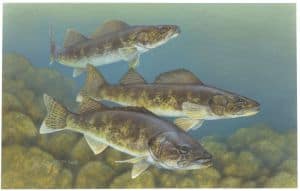
There are fewer young walleye in three big Boundary Waters lakes, and Department of Natural Resources (DNR) managers want to fix that for future fisherfolk. So, the agency has announced new size regulations to focus on older fish and improve the younger class’s spawning success.
On Saganaga, Sea Gull, and Gull Lakes, fish must now be at least 17 inches and anglers may have three in their possession. Last year, anglers could keep six fish, limited to one over 19.5 inches.
“Fish managers have been concerned for several years about low numbers of young walleye seen in these lakes, and the possibility that without some protection, those low numbers would result in even lower numbers of adult fish,” the DNR’s announcement stated.
The regulation will be in effect for 10 years, and will then be reviewed by the DNR and the public in 2024.
The most recent DNR survey of Sea Gull Lake turned up troubling trends, with the lowest numbers for sampling since 1956.
“Although several naturally-produced year classes contributed to the 2012 walleye catch, none appeared to have been strong. Two-year-old walleye made up the largest group sampled, but even their numbers were relatively low,” the report states.
It’s possible the population is crashing, or it could be that the the nets are missing where the walleye are. The agency uses one gill net placed in shallow water, and one in deep water, to sample fish. But the average fish length, two inches longer than similar lakes in the area, provides a hint toward another possible explanation.
“Fast walleye growth was probably due to the available cisco forage base, since yellow perch were almost completely lacking. It is possible that low walleye catches in this lake could be explained in part by higher-than-usual numbers of walleye suspending in mid-water areas to feed on suspended cisco.”
It was a similar story on Saganaga in 2011, where the catch was the lowest from the lake since 1964. While it was still within the normal range for its type of lake, the catch was less than half the goal in the lake’s 2008 management plan. It also seemed that one strong class six years ago and stocking contributed significantly to the population.
“The 2011 catch was dominated by a strong natural year class produced in 2007. Year classes supplemented by stocking (2009 and 2010) accounted for 21% of the walleye catch,” the DNR’s report states.
Elsewhere in the region, catch-and-release regulations for “genetically-unique” populations of lake trout in two lakes in Voyageurs National Park were implemented. A previously temporary regulation on Mukooda Lake was made permanent, with the goal to protect the fish for study. A new catch-and-release regulation was announced for Little Trout Lake for the same reason.

